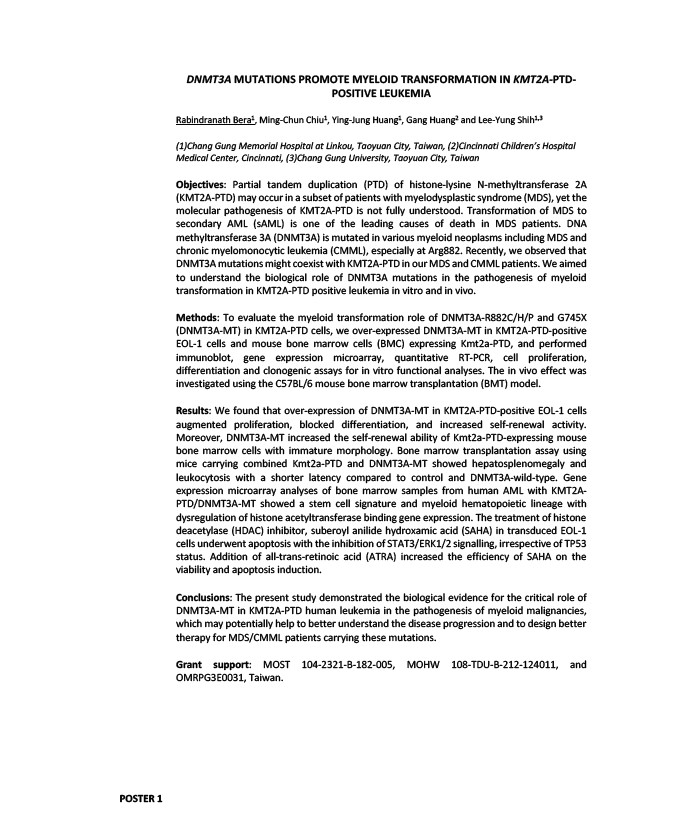
DNMT3A MUTATIONS PROMOTE MYELOID TRANSFORMATION IN KMT2A-PTD-POSITIVE
LEUKEMIA
Rabindranath Bera1, Ming-Chun Chiu1, Ying-Jung Huang1, Gang Huang2 and Lee-Yung Shih1,3
(1)Chang Gung Memorial Hospital at Linkou, Taoyuan City, Taiwan, (2)Cincinnati Children’s Hospital
Medical Center, Cincinnati, (3)Chang Gung University, Taoyuan City, Taiwan
Objectives: Partial tandem duplication (PTD) of histone-lysine N-methyltransferase 2A
(KMT2A-PTD) may occur in a subset of patients with myelodysplastic syndrome (MDS), yet the
molecular pathogenesis of KMT2A-PTD is not fully understood. Transformation of MDS to
secondary AML (sAML) is one of the leading causes of death in MDS patients. DNA
methyltransferase 3A (DNMT3A) is mutated in various myeloid neoplasms including MDS and
chronic myelomonocytic leukemia (CMML), especially at Arg882. Recently, we observed that
DNMT3A mutations might coexist with KMT2A-PTD in our MDS and CMML patients. We aimed
to understand the biological role of DNMT3A mutations in the pathogenesis of myeloid
transformation in KMT2A-PTD positive leukemia in vitro and in vivo.
Methods: To evaluate the myeloid transformation role of DNMT3A-R882C/H/P and G745X
(DNMT3A-MT) in KMT2A-PTD cells, we over-expressed DNMT3A-MT in KMT2A-PTD-positive
EOL-1 cells and mouse bone marrow cells (BMC) expressing Kmt2a-PTD, and performed
immunoblot, gene expression microarray, quantitative RT-PCR, cell proliferation,
differentiation and clonogenic assays for in vitro functional analyses. The in vivo effect was
investigated using the C57BL/6 mouse bone marrow transplantation (BMT) model.
Results: We found that over-expression of DNMT3A-MT in KMT2A-PTD-positive EOL-1 cells
augmented proliferation, blocked differentiation, and increased self-renewal activity.
Moreover, DNMT3A-MT increased the self-renewal ability of Kmt2a-PTD-expressing mouse
bone marrow cells with immature morphology. Bone marrow transplantation assay using
mice carrying combined Kmt2a-PTD and DNMT3A-MT showed hepatosplenomegaly and
leukocytosis with a shorter latency compared to control and DNMT3A-wild-type. Gene
expression microarray analyses of bone marrow samples from human AML with KMT2A-PTD/
DNMT3A-MT showed a stem cell signature and myeloid hematopoietic lineage with
dysregulation of histone acetyltransferase binding gene expression. The treatment of histone
deacetylase (HDAC) inhibitor, suberoyl anilide hydroxamic acid (SAHA) in transduced EOL-1
cells underwent apoptosis with the inhibition of STAT3/ERK1/2 signalling, irrespective of TP53
status. Addition of all-trans-retinoic acid (ATRA) increased the efficiency of SAHA on the
viability and apoptosis induction.
Conclusions: The present study demonstrated the biological evidence for the critical role of
DNMT3A-MT in KMT2A-PTD human leukemia in the pathogenesis of myeloid malignancies,
which may potentially help to better understand the disease progression and to design better
therapy for MDS/CMML patients carrying these mutations.
Grant support: MOST 104-2321-B-182-005, MOHW 108-TDU-B-212-124011, and
OMRPG3E0031, Taiwan.
POSTER 1